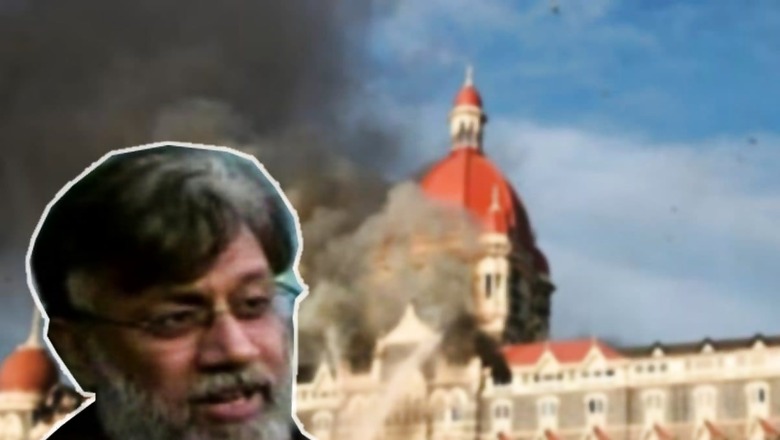
views
Tahawwur Rana’s extradition to India has been allowed by a United States court. He still has the option of appeal but India is relieved at this first win. If Rana’s extradition ultimately comes through, he will be the first foreign-based 26/11 conspirator to face the law of the land in India. David Coleman Headley, his friend and 26/11 conspirator, entered into a plea bargain with the US administration. The other conspirators led by Hafiz Mohammad Saeed and Zakiur Rehman Lakhvi enjoy Pakistan’s protection, which has repeatedly blocked all attempts by India to prosecute the 2008 Mumbai attack masterminds.
Why is Rana important?
62-year-old Tahawwur Hussain Rana, a Pakistani-Canadian national, had real-time knowledge about the 26/11 conspiracy. In 2013, he was sentenced to 14 years in jail for helping Lashkar-e-Taiba carry out the Mumbai attacks. He was a school friend of David Coleman Headley—a US citizen born to an American mother and a Pakistani father, who was arrested in October 2009 by United States authorities and sentenced to 35 years in prison for his role in the 2008 terror attacks.
Indian agencies believe Rana could hold more answers about how the 26/11 conspiracy was hatched, and how Headley managed to repeatedly enter India. Both attended the Hasan Abdal Cadet School in Pakistan. Rana worked as a doctor in the Pakistan Army before moving to Canada. Indian agencies believe a chance to question him about his time in Pakistan could provide India crucial insight.
Rana’s extradition could come with riders. When gangster Abu Salem was extradited from Portugal, “no death sentence” was the rider attached. But India is still upbeat about Rana possibly facing trial here because his testimony in Indian courts could be internationally cited as evidence about Pakistan’s terror conspiracy.
Appreciation for India’s evidence
Rana’s extradition order is also being seen as a thumbs up for India’s investigation and evidence-gathering.
As per the Indo-US extradition treaty signed in 1997, extradition is allowed only if the evidence placed on record against the accused prima facie shows his culpability in the crime. The NIA’s evidence presented in the US court by the Biden administration seems to have passed that test.
Judge Jacqueline Chooljian, while allowing extradition for Rana, said, “The court has reviewed and considered all of the documents submitted in support of and in opposition to the request, and has considered the arguments presented at the hearing. Based on such review and consideration and for the reasons discussed herein, the court makes the findings set forth below, and certifies to the Secretary of State of the United States the extraditability of Rana on the charged offences that are the subject of the request.”
The order from the US Magistrate Judge of the US District Court Central District of California was pronounced after keeping it in abeyance since November 2021.
Appreciation of the 26/11 evidence by a US court is not just a legal but also a moral victory for India since Pakistan has repeatedly questioned the quality of evidence presented in multiple dossiers by India. Islamabad has defended its inaction against Hafiz Saeed, Lakhvi, and others on the grounds that Pakistani courts have found the evidence provided by India inadequate. Given the stringent scrutiny the same evidence was put through by the US establishment and judiciary, India is bound to use this to expose Pakistan internationally, yet again.
Lessons learnt
India through the Rana extradition process has also learnt about the international standards for evidence presentation against fugitives wanted by it. The initial extradition request against Rana was made in 2012, which was not accepted by the US. In 2018, a second attempt was made when a team of NIA officials visited the USA. Evidence was presented to show that Rana was aware that his childhood friend Pakistani-American David Coleman Headley was involved with Lashkar-e-Taiba (LeT). India also produced proof that Rana misused his travel agency to provide cover to Headley during his India visit to recce Mumbai, Delhi, and Pune. The reworked extradition request included evidence that Rana knew of who Headley was meeting in connection with the 26/11 conspiracy, what was discussed, the planning, and even the targets.
A convinced US government later argued in court that by assisting Headley and affording him cover for his activities, Rana supported Lashkar and its associates. The US government asserted that Rana was part of the 26/11 conspiracy, committed the substantive crime of commission of a terrorist act. and therefore must be extradited to India.
On June 10, 2020, India filed a complaint seeking the provisional arrest of Rana with a view towards extradition.
Perseverance
Rana’s extradition also threw repeated challenges at India’s diplomatic, legal, and investigating teams. Though he was convicted for 14 years in 2013, his premature release was all but certain in 2020 when on grounds of good behaviour he was granted parole. The decision came suddenly and India had to move swiftly to ensure that his release was prevented. Top officials who are aware of the extradition efforts said that if Rana, a Canadian national, was released and allowed to go to Canada, extradition would have been impossible. This was the period when the world had come to a standstill because of the Covid pandemic and helping an Indian team travel to the USA to push for extradition was a humongous task. India not only ensured the team’s presence in the US on more than one occasion during the Covid lockdown but also clarified doubts that the US legal team had real-time. The time difference between the two countries was a challenge to overcome.
Rana still has two appeals in US higher courts before the final decision on his extradition is taken. But India is already moving diplomatically to ensure that the process is expedited.




















Comments
0 comment